Meerkats have long been popular subjects of fascination – it’s no wonder why! With their adorable, pointed faces and beautiful brown-striped fur, these delightful creatures are often found topping polls for favourite animals. Found living in African savannas and grasslands, meerkats are a type of small mongoose part of the Herpestidae family.
Table of Contents
They typically weigh between 1.4 to 2.1 pounds and measure about 20 inches end to end including their tail – a perfect size to fit into the underground burrow they dig using their sharp claws.

They are incredibly social animals, living and working in groups of 20-50. During the day they search for food such as insects, scorpions and even bird eggs, but remain ever alert for danger. Upon sensing any potential threat to the group, one meerkat will stand sentry duty while others retreat to their underground burrows – if danger is near meerkats will bark and whistle a warning signal so the other members know it’s time to take cover.
Though the meerkat is in its own genus (Suricata), there are several other species that display similar behaviours; from their fox-like relatives like Hillers Richardson and black-footed mongooses to the very similar-looking African yellow mongoose.
In this article, we will tell you about different animals like meerkats stay tuned while we begin our amazing journey.
1. Yellow Mongoose
Scientific name: Cynictis penicillata
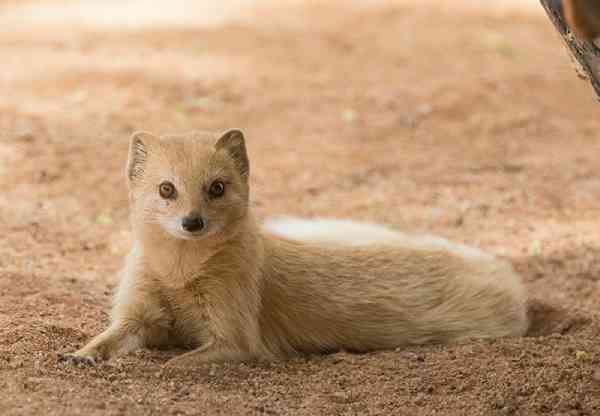
Fun fact: Meerkats and yellow mongooses are closely related and have a lot in common physically. They have frequently observed cohabiting.
Yellow mongooses share many of the same distinct physical features as their cousins, the meerkat. With yellow fur underneath a brown coat and a bushy tail, they are sometimes mistaken for red meerkats.
These creatures typically reach around 20 inches in length and weigh up to 1 lb., boasting strong and long claws for digging underground when it’s time to sleep. Burrows are often shared not only between these animals themselves but also among other species like meerkats.
They stand upright with their hind legs, keeping alert for any potential danger that may be lurking about. Much like the closely-related meerkat, yellow mongooses live in large social groups that stick together through thick and thin.
Not only do they share a cooperative approach to raising young but hunting ceases to be a lonely affair when these critters team up with their close relatives!
2. Prairie Dog
Scientific name: Cynomys
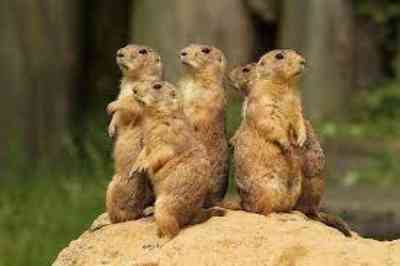
Fun fact: A squirrel belonging to the Sciuridae family exhibits social behaviour akin to that of meerkats.
Prairie dogs are a species of rodent belonging to the Sciuridae family that live in the grasslands of North America. Their diet consists of things such as insects and grass, and they grow to about 16 inches and weigh between 1 to 3 pounds.
They have short tails, small rounded ears, and really strong claws which help them keep watch from their burrows and defend their territories. Prairie dog fur is typically tan in colour with a paler belly, along with being short and coarse.
This species is one of nature’s most sociable animals, living in large groups as seen with other creatures like meerkats. Not only do they live together, but also communicate collectively through a range of kinds of warning noises regarding predators that come near.
3. Banded Mongoose
Scientific name: Mungos mungo
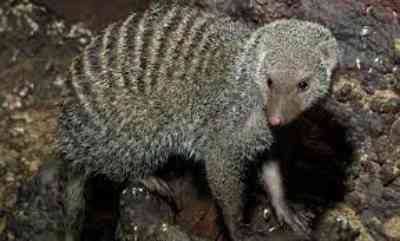
Fun fact: Banded mongooses are meerkat cousins who are outstanding snake killers.
Banded mongooses are intriguing creatures found in the open grasslands of central and eastern Africa. With a gruff brownish-grey coated appearance and dark bands that traverse their backs, they have strong sharp snouts, short legs, long bodies and long curved claws ideal for digging and scratching.
Growing up to 18 inches in length and weighing as much as 5.5 pounds, they’re known to feed on insects such as termites, beetles, millipedes and scorpions. As if this is not enough, the banded mongoose is also renowned for its ability to vanquish snakes!
This unique skill involves provoking snakes similar to cobras by taking bites out of their tail until the snake is too exhausted or scared to continue fighting – an impressive feat indeed from such a small creature.
They form larger groups than most other mongoose species with tribes composed of up to 40 members – even matching those of meerkats!
4. Weasel
Scientific name: Mustela
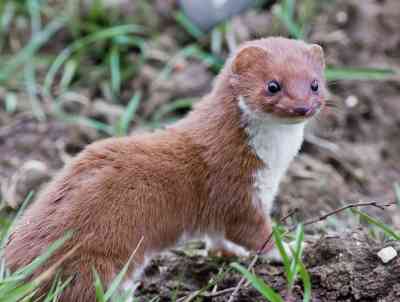
Fun fact: Weasels use their rear legs to survey their surroundings and detect danger.
Weasels are small carnivorous mammals that belong to the Mustelidae family. Although they share similarities with meerkats, such as short legs and rounded ears, the length of a weasel can range from 15 to 24 inches from nose to tail and their fur has various colourings of brown, black and grey with hints of white and yellow here and there.
Depending on how far north they live in the colder climates, weasels may turn completely white in the winter months as an added form of camouflage. But like meerkats, these fascinating creatures possess a heightened sense of alertness at all times; distinguished by their long necks and large eyes, these mammals are always on the lookout for potential prey or predators – even standing up on hind legs to gain an optimal view of their surroundings.
5. Marmot
Scientific name: Marmota

Fun fact: A hairy rodent that makes a characteristic warning noise.
Marmots are cute, furry rodents that make an excellent addition to European, North American, and Asian mountains. With claws specially adapted for digging and strong enough to do so 30 feet in length, these animals can provide shelter from the cold winter months with their burrows.
Belonging to the same family as prairie dogs and ground squirrels, marmots also share certain behaviours with their cousins such as looking out for predators by standing upright on their hind legs as meerkats do.
Moreover, marmots are known for their distinct loud whistle noises meant to be a warning sign for when danger has been sensed – this peculiar trait gave them the nickname “Whistle Pig”.
6. Dwarf Mongoose
Scientific name: Helogale parvula
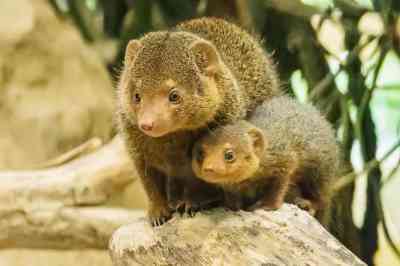
Fun fact: a tiny mongoose with meerkat-like characteristics.
The dwarf mongoose is an admirable creature and the smallest of all carnivores in Africa. Its fur can vary from speckled brown to reddish-buff, measuring only 7 to 11 inches and with pointy faces and small ears.
Though their life span in the wild is generally 10 to 14 years, their majestic presence can be enjoyed longer in captivity as they can hit 18 years of age there.
These beloved animals have an intriguing communal lifestyle – groups of dwarf mongoose live close together, never straying too far from one another and allowing the alpha male to stand watch on a termite mound while making noises that let the rest of the family know when danger is imminent.
Dwarf mongooses are curious animals whose main diet consists of tasty insects which they carefully search out every day.
7. Raccoon
Scientific name: Procyon lotor
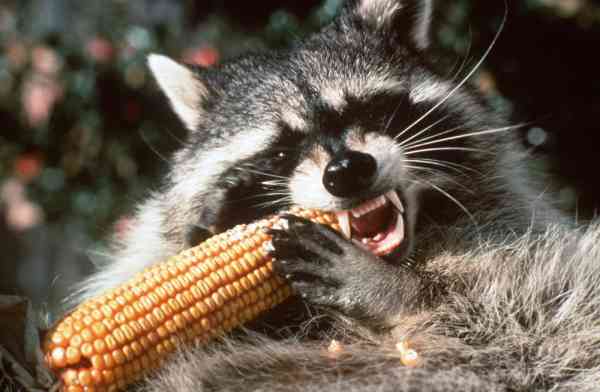
Fun fact: Procyonidae family member; meerkats and this family have some morphological similarities.
With their signature patches around their eyes and distinctive pointed snouts, raccoons bear an uncanny resemblance to meerkats. Raccoons are larger than other members of the Procyonidae family, measuring 16-28 inches in length on average. Found in North American woodlands, farmlands, and urban habitats, these omnivorous animals seek out diverse food sources ranging from fruit and nuts to small mammals and insects.
They have a surprisingly long lifespan for wild animals ranging from 2-5 years, with some living up to 14 years in captivity. Social animals at heart, these cuddly creatures can be found living together in packs or small social groups for companionship and safety.
8. Rock Hyrax
Scientific name: Procavia capensis

Fun fact: a little animal found in the Middle East and Africa that dwells in huge colonies.
The rock hyrax is an animal native to the Middle East and Africa that might easily be mistaken for a rodent at first glance. Its brownish-grey, furry coat, short ears, and short sturdy legs paint it as a rather adorable creature.
This intriguing mammal can grow up to 22 inches (56 centimetres) in length, typically weighing between 4 to 12 pounds (2 to 5 kilograms). Despite their resemblance to rodents, they are actually members of the Procaviidae family which places them closer to elephants or manatees than anything else.
Rock hyraxes have versatile diets feasting on a variety of plants such as lobelia and particularly enjoying insects and grubs like meerkats do. As social animals, they live in colonies ranging from five to sixty individuals where it isn’t unheard of for one individual to play lookout for any potential threats–alerting others with song should danger strike.
9. South African Ground Squirrel
Scientific name: Geosciurus inauris
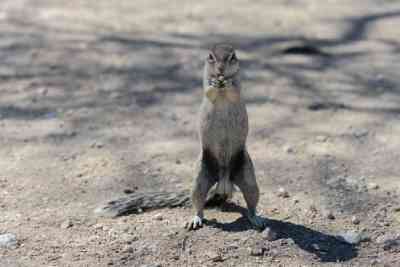
Fun fact: A little squirrel related to meerkats in appearance.
The Cape ground squirrel, also referred to as the South African ground squirrel, is often mistaken for meerkats due to its small size and round ears. Its body length is approximately 16.7–18.7 inches meaning they are of a similar size to that of its distant cousin, the meerkat.
Ground squirrels prefer much the same environment as meerkats, burrowing and living in large groups on open plains with hot temperatures. Whilst scouring their territory for food or safety risks these little critters are often seen standing upright with their furry head assumed to be on the lookout for danger – spotting a threat would require an alert in the form of a loud warning chirp or whistle, allowing other animals staying close by provides all-round protection from imminent peril.
10. Chipmunk
Scientific name: Tamias
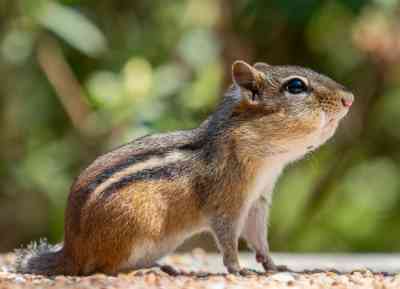
Fun fact: a little ground rodent that enjoys digging burrows.
Chipmunks are some of the most beloved animals in our world, from the films that so often feature them to those who enjoy them outside in nature. Found across much of North America and Asia, chipmunks tend to be rather small creatures with a body length ranging between 3.1 and 6.3 inches – usually smaller than meerkats.
They have a distinct appearance, boasting brown or grey stripes on their fur bodies as well as curious faces that have charmed many an onlooker! When it comes to their diet, chipmunks can be quite similar to meerkats; they enjoy both fruit and seeds while also having a penchant for insects.
But they are more than just cute little outdoor creatures; chipmunks themselves make excellent engineers by building burrows up to 11 feet long when necessary! They are also quite adept at looking out for each other – they’ll make warnings if they spot potential danger nearby.
11. Fossa
Scientific name: Cryptoprocta ferox
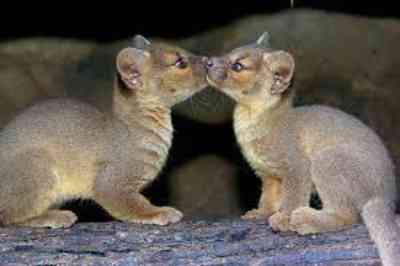
Fun fact: A carnivore that is related to meerkats, mongooses, and civets.
The fossa is an intriguing species, a close relative of both the meerkat and mongoose but with a much larger body. This cat-like creature from the forests of Madagascar stands up to 6 feet long and can weigh around 26 pounds.
Despite its impressive size, it has the same cute pointy face and little ears as its relatives and its short, dense coat is generally a rich brown colour with a hint of gold on its underside. The fossa’s main source of food is lemurs but they also feed on lizards, fish mice, birds, and wild pigs.
This incredible species is in danger however – there are only 2,500 left in the wild due to habitat loss and so they have been classified as vulnerable. Fortunately though if cared for correctly their average life span can reach up to 20 years in captivity.
12. African Civet
Scientific name: Civettictis civetta
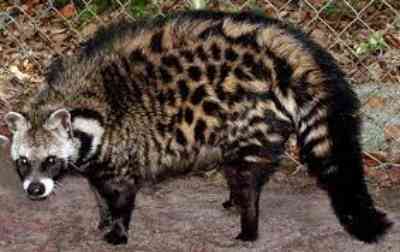
Fun fact: A small, thin mammal related to mongooses has meerkat-like facial traits.
African civets, sometimes called civet cats by people unfamiliar with their true heritage, are small and lean animals more closely related to mongooses than cats. With small ears, pointed snouts like that of meerkats, and thick fur ranging from greyish colour to black spots in rows, these imposing feline-like creatures have a distinctive look and definitely stand out in the wild.
One remarkable trait of African civets is their size – they can weigh up to 44 pounds with a body length of 26 inches and a tail length of 19 inches; with their agility though, they can swiftly manoeuvre through any terrain. On average, they live for 15 to 20 years although some may exceed this lifespan if kept in captivity properly.
Moreover, African civets have an omnivorous diet consisting of insects, fruits, vegetables and larger prey such as poultry and young lamb making them one interesting animal to observe.
13. Mink
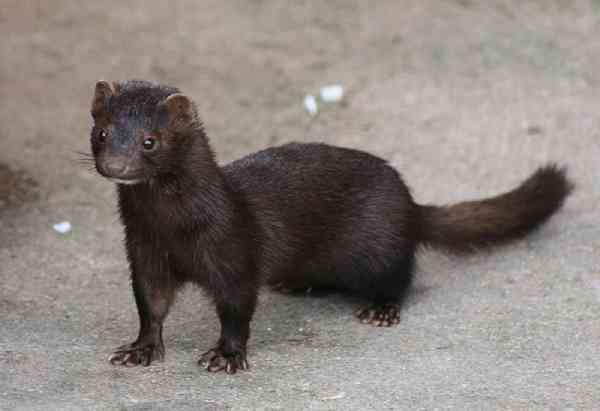
Fun fact: Several people mistake minks for rodents, yet minks are not related to rodents.
The mink is a fascinating semi-aquatic mammal that lives in North America and Eurasia. With their elongated and thin bodies, pointed snouts, and sharp claws, they look like a meerkat on steroids. Minks are incredible animals that demonstrate agility: they can swim up to 100 feet underwater and also jump from tree to tree with ease.
Not only that but if they’re having a good time, minks might even purr – which could make one wonder how something so small can be so loud! When it comes to hunting for food, minks are quite savvy predators; with their swiftness and agility, these furry creatures catch mice, chipmunks, frogs, snakes and birds with enough skill to dispatch them quickly with a bite to the neck.
Final Words
Although meerkats belong to the Suricata genus, they have several similarities with their family member, the mongoose. Things like the shape of their muzzle and physical behaviour are shared between these two animals. This commonality may be due to their previously shared family ties: the Viverridae family.
It is not just mongooses that share certain characteristics with meerkats, however – even other inhabitants of the African savannahs, such as striped polecats, look surprisingly similar. Their environments are similar too, which can make it hard to spot any differences when they share a burrow or cross paths in a given habitat.
Fortunately, though, we now understand that these animals belong to different families and have some clear distinctions that differentiate them.
Reference:
https://www.pbs.org/wnet/nature/blog/meerkat-fact-sheet/
https://www.gadventures.com/blog/lion-king-animals-travel/

Jeevan Kodiyan
An animal enthusiast with an interest in zoology, studying the behavior and activities of animals in the wild habitat. I work on research projects related to species conservation and endangered species protection. I also leverage zoology to become an educator, educating others about the importance of protecting our natural environment and the beauty of animals in their natural habitats.








